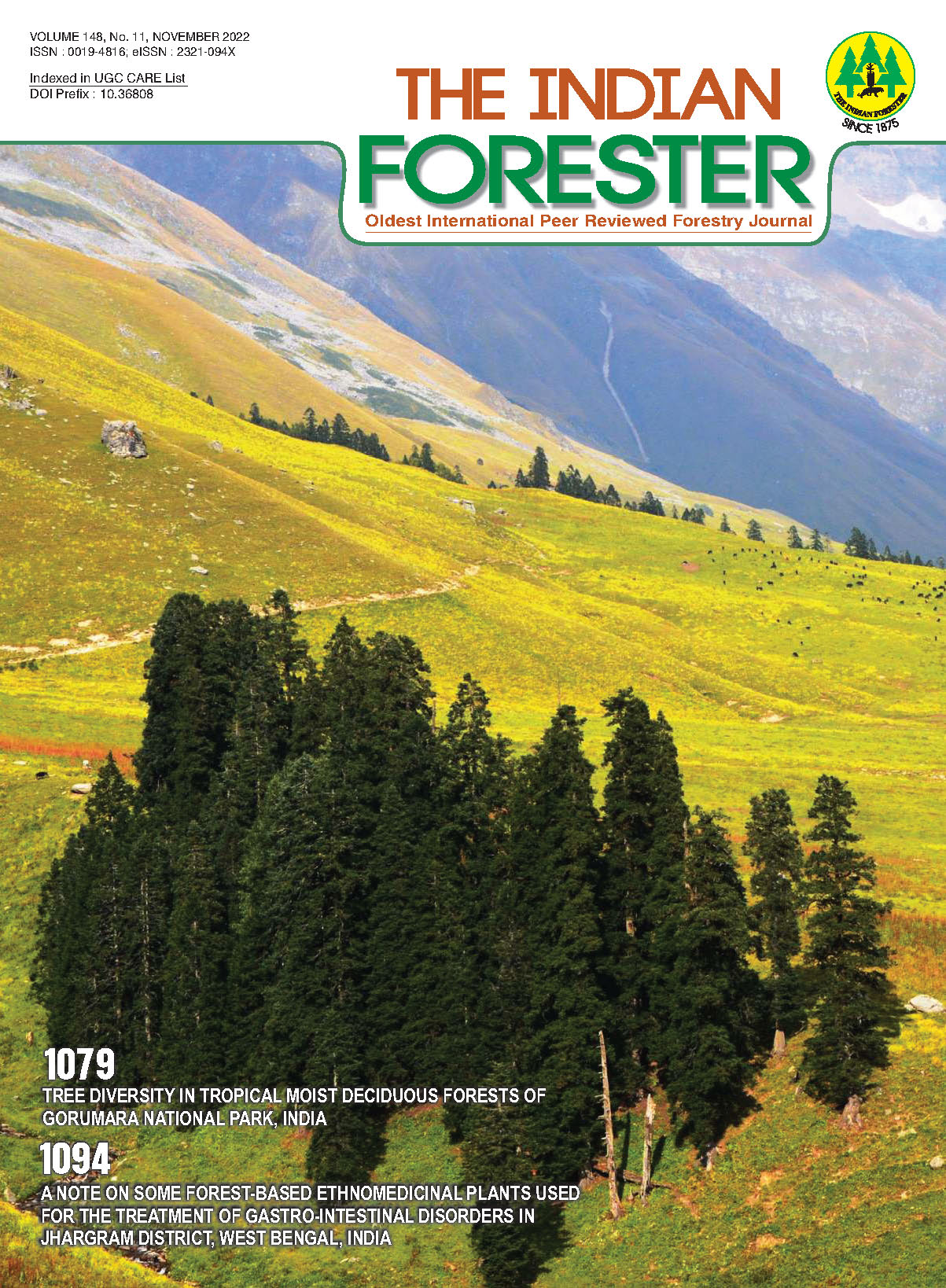A Review on the Demand status and Strategies for Conservation of Brihad Panchamoola Species
DOI:
https://doi.org/10.36808/if/2022/v148i11/166460Keywords:
Brihad Panchamoola, Threatened, CAMP, Chemotype, Herbal IndustryAbstract
The Indian Systems of Medicine has a long tradition of using medicinal plants. Various parts, such as roots, bark and leaves, are harvested, processed and used to prepare herbal formulations. Dasamoola, one such herbal formulation consumed for general health improvement, uses roots of five medicinal trees, Aegle marmelos, Premna integrifolia, Oroxylum indicum, Stereospermum suaveolens, Gmelina arborea. As the root is the major constituent of the formulation, the five species are destructively harvested from wild, leading to depletion of their genetic stocks. This commercial exploitation has pushed the species to threatened levels in the wild, as reported through CAMP Workshops. The increasing demand for the formulation and the widening demand and supply gap for raw materials has encouraged research on various aspects of these five species. The paper describes the demand of the species both at industry and household levels, leading to their threatened status, there is need for research to conserve the resources and strategies for sustainable use.References
Alka, J.K. and Pathak, P. (2020). Management of COVID-19 from Ayurveda perspective, Pharma Science Monitor, 11 (3) : 49-55.
Dhakulkar, S. Bhargava, S. Ganapathi, T. R. and Bapat, V. A. (2005). Induction of Hairy roots in Gmelina arborea Roxb and production of verbacoside in hairy roots, Plant Science, 169: 812-818.
Ghate, V.S. and Sathe, M.M. (2001). Collection and nursery evaluation of Bruhat-Panchmula germplasm, Journal of Medicinal and Aromatic Plant Scio nceg, 46-50.
Goraya, G. S. and Ved, D. K. (2017). Medicinal Plants in India: An Assessment of their Demand and Supply. Naonal Medicinal Plants Board, Ministry of AYUSH, Government of India, New Delhi and Indian Council of Forestry Research & Education, Dehradun + 430pp.
Jabbar, S. Khan M.T. Choudhuri, M.S. Sil, B.K. (2004). Bioactivity studies of the individual ingredients of the Dashamularishta, Pakistan Journal of Pharmaceutical Sciences, 17: 9 17.
Mohana Priya, S. Indhu, S. Kalaiselvi, R. and Warrier, R.R. (2020). Agrobacterium-mediated transformation in medicinal trees. Annals of Phytomedicine, 9 (1): 27-31.
NMPB, 2019a. https://www.nmpb.nic.in/sites/default/files/Achievements_NMPB_31_March_2019.pdf
NMPB, 2019b. https://www.nmpb.nic.in/sites/default/files/Conservation/Conservation_1_In_situ_Conservation_PDF.pdf
NMPB, 2019c. https://www.nmpb.nic.in/sites/default/files/Conservation/Conservation_2_Ex-situ_Conservation_PDF.pdf
Parekar, R.R. Bolegave, S.S. Marathe, P.A. Rege, N.N. (2015). Experimental evaluation of analgesic, anti-inflammatory and anti-platelet potential of Dashamoola, Journal of Ayurveda and Integrated Medicine, 6: 11-8.
Pasrija, A. Popli, H. Mitra, R.C. Singla, C. Dhiman, A. and Jain, K. (2021). Brihatpanchmoola: An Overview of Morphological, Phytochemical and Biological Profiles, International Journal of Current Research and Review, 57-66.
Sivakumar, V. Warrier, R.R. Anandalakshmi, R. Parimalam, R. Chandaran, S.V. and Singh, B.G. (2006). Seed storage studies in Aegle marmelos and Feronia elephantum, Indian Forester, 132 (4): 502-506.
Ved, D.K. and Goraya, G.S. (2007). Demand and supply of medicinal plants in India. NMPB, New Delhi & FRLHT, Bangalore, India, 18.
Warrier, R.R. Anandalakshmi, R. and Singh, B.G. (2012). Establishment of Seed Production Systems for Non-Timber Forest Products–An Approach to Sustainable Utilisation. ENVIS Forestry Bulletin. 12(2): 29-32.
Warrier, R.R. Geetha, S. Sivakumar, V. Singh, B.G. and Anandalakshmi, R. (2020). Threatened Tree Species of the Western Ghats: Status, Diversity and Conservation. In Conservation and Utilisation of Threatened Medicinal Plants. Springer, Cham. pp. 429-460).
Warrier, R.R. Priya, S.M. and Kalaiselvi, R. (2021). Gmelina arborea - An indigenous timber species of India with high medicinal value: A review on its pharmacology, pharmacognosy and phytochemistry. Journal of Ethnopharmacology, 10.1016/j.jep.2020.113593
Warrier, R.R. Viji, J. and Priyadharshini, P. (2010). In vitro propagation of Aegle marmelos L. (Corr.) from mature trees through Enhanced Axillary Branching. Asian Journal of Experimental Biological Sciences, 1 (3): 669–676.
Warrier, R.R. Anandalakshmi, R. Sivakumar, V. and Singh, G.B. (2016). Establishing Propagation Methods for Oroxylum indicum. ENVIS Newsletter on Medicinal Plants. 9 (1-4): 14-15.
Downloads
Downloads
Additional Files
Published
How to Cite
Issue
Section
License
Unless otherwise stated, copyright or similar rights in all materials presented on the site, including graphical images, are owned by Indian Forester.





